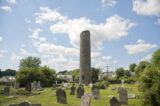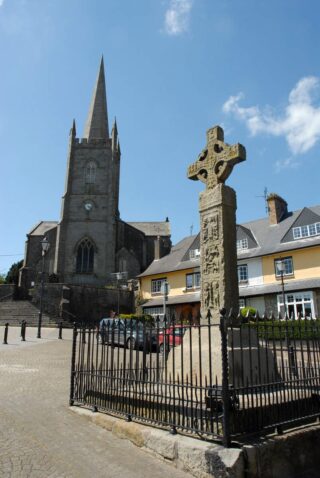Clones Round Tower, Church and High Cross
Part of an early monastic settlement founded by Saint Tighernach
Unguided sitesFógra
WARNING: It should be noted that these sites are unguided and a level of care and caution should be maintained during all stages of your visit. The Office Of Public Works (OPW) will not be held responsible for any damages, injuries, or losses that occur
Clones Round Tower, Church and High Cross
The early monastic settlement of Clones was founded in the 6th century by St. Tighernach. St. Tighernach was bishop of Clogher, as well as bishop of Clones, after performing many miracles around Ireland, Britain, and France. The origins of the town of Clones are from an ancient church founded by St. Tighearnach who is said to have been baptised by St. Brigid at Kildare.
The 4 storeyed, sandstone round tower has its entry door 1.5m above ground level, and stands at 23m, with its conical cap missing. During the 1840’s the interior of the tower was cleared where human remains were found beneath the floor on the ground level. It is believed the remains were from a pre-existing graveyard, over which the round tower was built.
The simplicity of the doorway and slit windows indicate a build date of the early 10th century. Of the typical cardinal windows located beneath the conical cap, all but one are missing, only the east window still remains. The round tower was a necessary safety feature for all financially thriving monastic settlements, as it was where the riches of the settlement were stored in times of attack from the Irish and Vikings. Clones was raided and plundered by the Vikings in 836AD, and destroyed by fire in 1095, rebuilt and destroyed again by fire in 1184.
The monastery founded by St. Tighernach, became the Augustinian abbey of Saints Peter and Paul in the 1140’s. The abbey once held a copy of the Gospels that St. Patrick gave to St. Mac Caorthainn, known as The Domhnach. The church dates from middle of the 12th century. It is believed the church was built for the Augustinian Order of Canon Regulare in approximately 1150.
Indulgences were granted to the abbey in 1414, and by 1586 Sir Henry Duke leased the area from the Crown. The area was inherited by the Barret-Leonard family and held by them into the 19th century.
The High Cross has, for centuries, been located at the Diamond in Crossmoyle. The cross is comprised of a Head and Shaft of two different High Crosses.
Visit Historic Environment Viewer for more information on Clones Round Tower & Church
Protect our Past - Click here to read about the importance of protecting our country’s unique heritage sites
This national monument is protected in accordance with the National Monuments Acts 1930 to 2014





